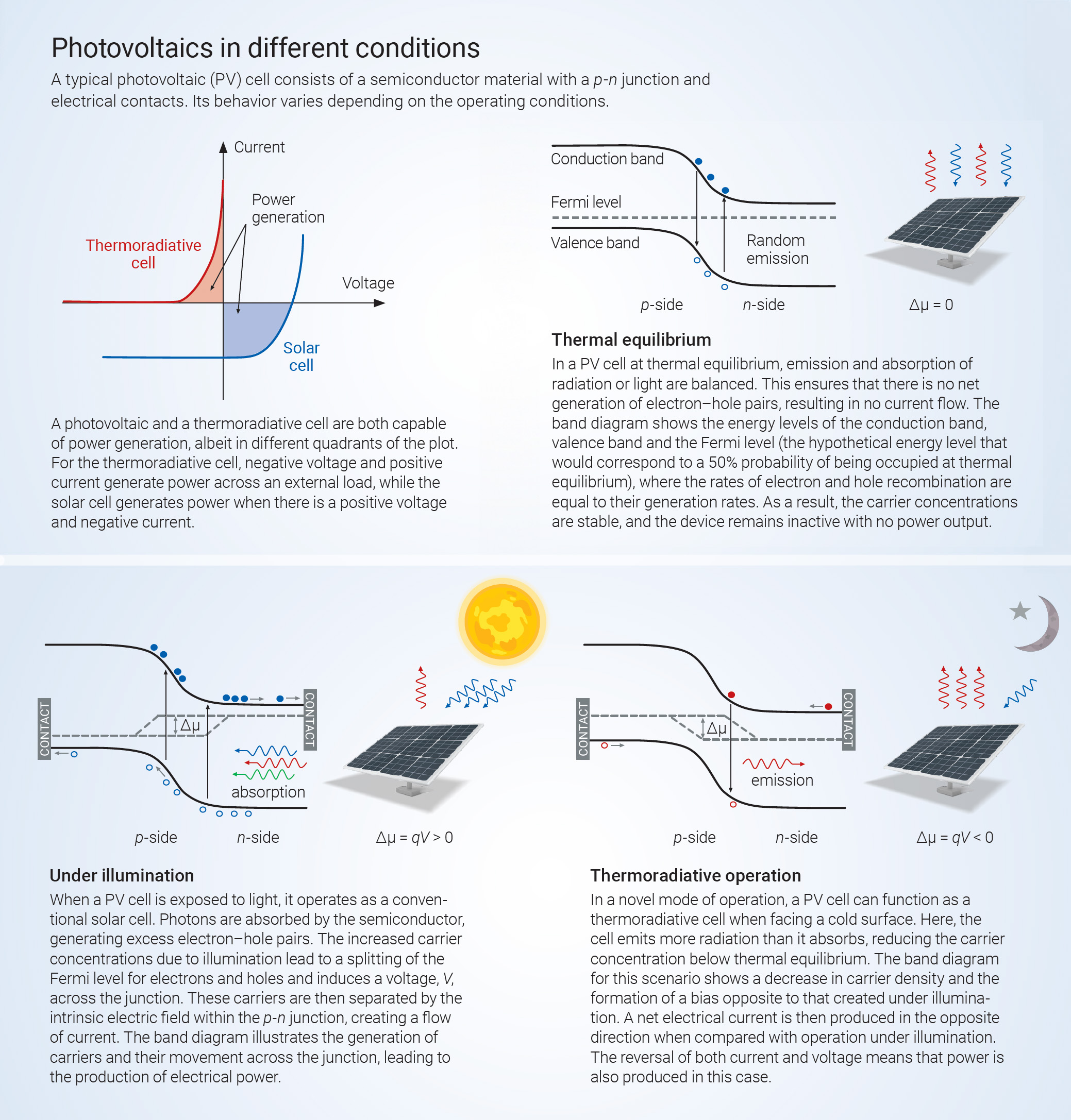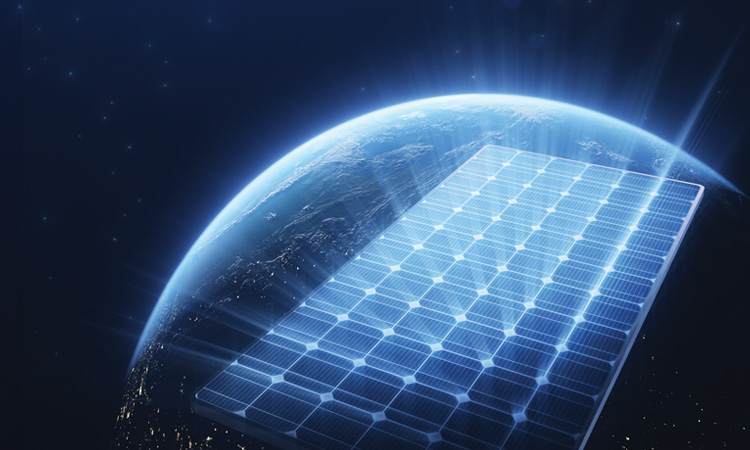 [Munday Lab, UC Davis]
[Munday Lab, UC Davis]
As the world works to reduce carbon emissions, solar power is becoming a larger fraction of global electricity production. In California, 20% of electricity is generated from solar. However, once the sun goes down, we are left in the dark in the absence of energy storage or other forms of power.
But what if a photovoltaic device were able to produce power even after the sun set? Welcome to the world of thermoradiative photovoltaics. This article discusses how these devices can operate like solar cells “in reverse” to create power at night, scavenge waste heat, or power spacecraft through a combination of novel optics, thermodynamics and semiconductor physics.
 Work can be extracted from a heat engine as energy flows from a hot body to a cold body. For example, as energy flows from the sun to Earth, a photovoltaic solar cell can extract power in the form of electricity. Similarly, a thermoradiative cell can extract power from “hot” Earth as energy is radiated toward cold space.
Work can be extracted from a heat engine as energy flows from a hot body to a cold body. For example, as energy flows from the sun to Earth, a photovoltaic solar cell can extract power in the form of electricity. Similarly, a thermoradiative cell can extract power from “hot” Earth as energy is radiated toward cold space.
Physics of thermoradiative photovoltaics
In a useful abstraction, a photovoltaic solar cell can be viewed as a heat engine. A heat engine requires two bodies at different temperatures to produce usable power. For the solar cell, the sun is the hot body, and Earth is the cold body. As energy flows between the sun and Earth, the solar cell extracts a fraction of it, through the photovoltaic effect, to produce electrical power.
Once the sun has set, it may appear that we no longer have a hot body as the source of heat; however, that is not quite correct. Earth is relatively warm compared with the cold of space.
Once the sun has set, it may appear that we no longer have a hot body as the source of heat; however, that is not quite correct. Earth is relatively warm (at 300 K) compared with the cold of space (at 3 K). In this respect, Earth can act as the hot body, and space becomes the cold sink. Although Earth radiates significantly less power than the sun due to its lower temperature, the Carnot efficiency (η = 1−TC/TH, where TC is the temperature of the cold body and TH is the temperature of the hot body) of a device operating between the temperatures of Earth and space is actually higher (99%) than that operating between the temperatures of the sun and Earth (95%). Might it be possible to create a photovoltaic device that could extract power when operating between Earth and space?
A traditional solar cell generates power by absorbing sunlight to create current and voltage. The absorption of sunlight leads to an increase in the densities of electrons and holes compared with their equilibrium values. The increased carrier densities result in a different Fermi level for electrons and holes. This difference, referred to as the quasi-Fermi level splitting, creates a bias voltage across the cell when illuminated. When an appropriate load is attached to the cell, current flows. The resulting current (I) and voltage (V) produce power (P = IV).
What happens when the photovoltaic cell on Earth is pointed at the darkness of space rather than the sun? Instead of generating excess charge carriers, as under solar illumination, the carrier densities decrease compared with their equilibrium values. This decrease occurs because the cell is facing a colder object (space) that does not supply the necessary energy to repopulate the carriers lost to recombination in equilibrium. Because the resulting carrier densities are different from their equilibrium values, a quasi-Fermi level splitting again occurs.
However, this time the splitting is in the opposite direction and results in a bias voltage of opposite sign to that occurring during illumination. When a load is attached, current can again flow, but the current flows in the opposite direction—attempting to repopulate, rather than extract, the charge carriers in the cell. Because both the voltage and the current change sign, the sign of the power (P = IV) remains the same. Thus, this device produces power by reversing both the voltage and the current simultaneously, compared with traditional photovoltaic operation. When operating in this configuration, the device is termed a thermoradiative cell.
Because a thermoradiative cell produces power when facing a cooler surface, power can be generated at night (without the sun) by pointing it toward the sky. By contrast, a silicon solar cell has access to about 1000 W/m2 of power on a sunny day, and, of that, a typical commercial cell can generate about 200 W/m2 throughout eight hours of daytime operation. Given the similarities between a thermoradiative cell and a traditional solar cell, it’s natural to ask if the same silicon photovoltaic could be used for both applications. That is, could a rooftop solar cell already be producing power at night? The short answer is “no.”
A silicon cell has a band gap (1.1 eV) that is well-matched to the incident solar irradiation, meaning that the cell can absorb a large fraction of the power emitted from a blackbody at 6000 K and convert it efficiently into electricity. For nighttime operation, though, the emitting body is the cell on Earth, which has a much lower temperature of about 300 K. Thus, an ideal thermoradiative cell would need a much lower band-gap energy (less than 0.1 eV) to efficiently convert this spectrum into electricity. A silicon photovoltaic operating as an ideal thermoradiative device would produce less than 10−14 W/m2, while an ideal thermoradiative device with a much lower band-gap energy could surpass 50 W/m2.
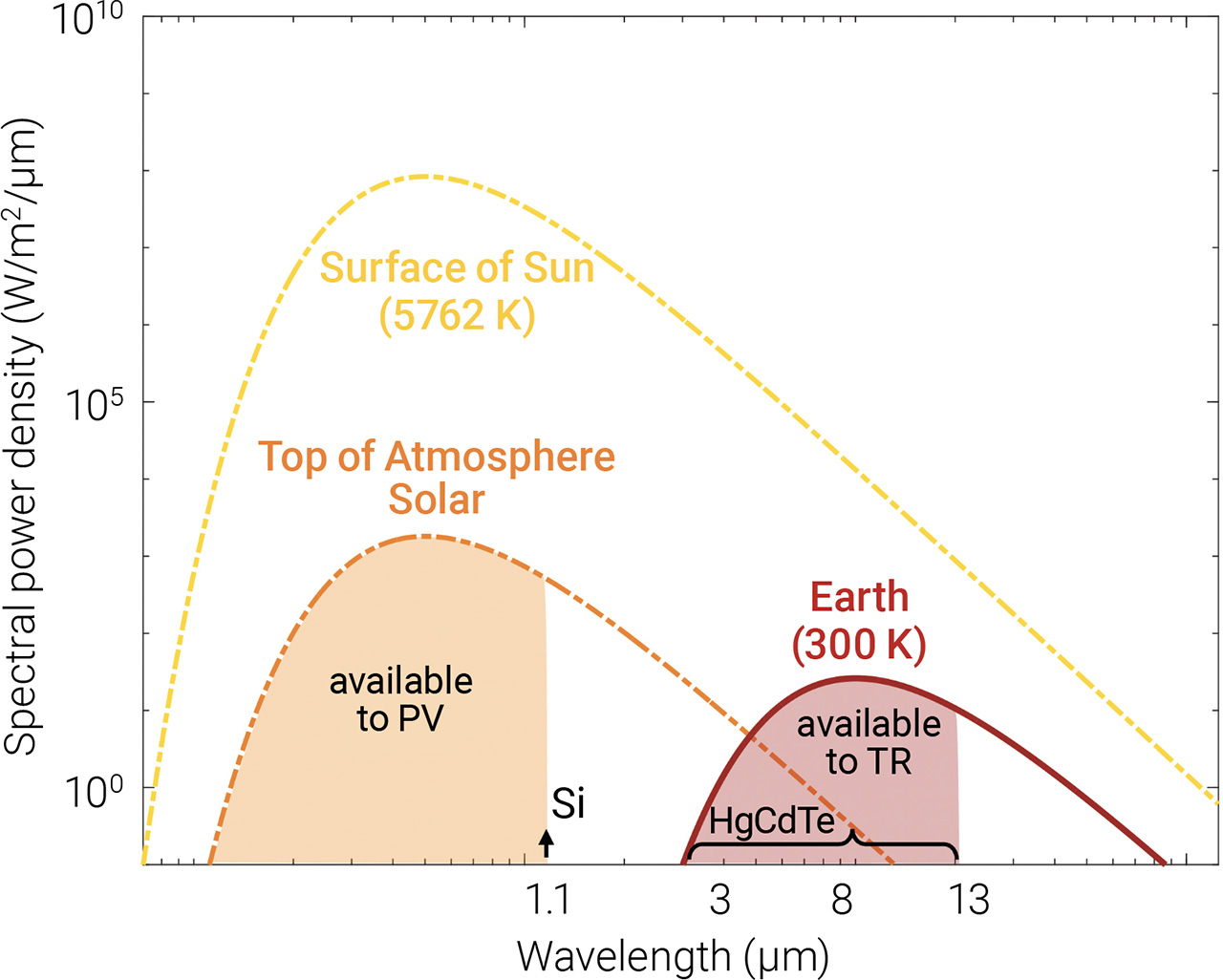 [Enlarge image]The spectral power density available from the sun and Earth. Because they occupy different portions of the electromagnetic spectrum, different semiconductors are needed to effectively use their spectral emission.
[Enlarge image]The spectral power density available from the sun and Earth. Because they occupy different portions of the electromagnetic spectrum, different semiconductors are needed to effectively use their spectral emission.
Generating power from the night sky
The scientific community has only recently explored creating electrical power on Earth via the cold of space. A sky-facing thermoradiative cell can produce power by converting local thermal energy into electricity through radiative coupling to a more distant cool body. This effect was first demonstrated by P. Santhanam and S. Fan in 2016. An off-the-shelf HgCdTe infrared diode was placed in view of a temperature-controlled infrared-emissive surface. The photocurrent of the diode was measured to switch in polarity as the temperature of the emissive surface switched from hot to cold with respect to the diode.
A sky-facing thermoradiative cell can produce power by converting local thermal energy into electricity through radiative coupling to a more distant cool body.
The thermoradiative effect was further characterized in 2022 by N.J. Ekins-Daukes and coworkers by using various-band-gap HgCdTe diodes to understand the loss mechanisms in this potential energy-recovery device. They performed variable-load current–voltage power measurements and achieved a power density of 2.26 mW/m2 at a modest temperature differential of 12.5 K. Calculations including nonradiative processes showed agreement between theory and experiments.
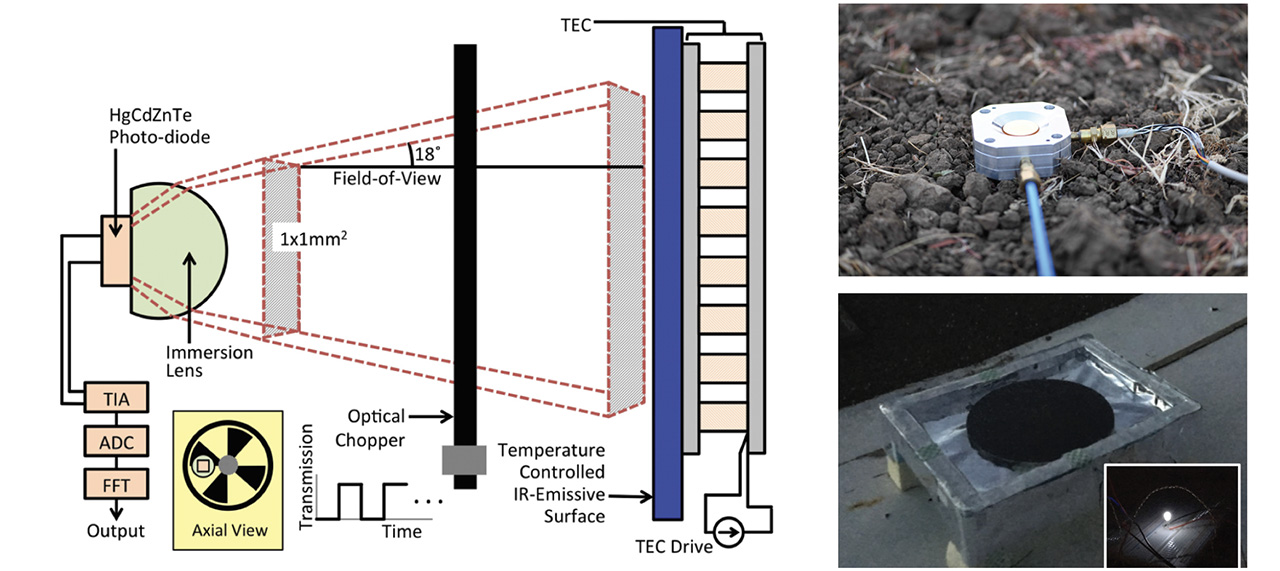 [Enlarge image]Recent work to produce electricity at night via the cool sky
[Enlarge image]Recent work to produce electricity at night via the cool sky
Left: Schematic of a typical laboratory experiment. Right: Outdoor experiments using thermoelectric devices to generate electricity (top) and operate an LED through radiative coupling with the night sky (bottom). [P. Santhanam et al. Phys. Rev. B 93, 161410 (2016). Copyright 2016 by APS / Munday Lab / A.P. Raman et al. Joule 3, 2679 (2019) with permission from Elsevier]
While these experiments demonstrated the ability to produce power by radiatively coupling to a cold source, both demonstrations took place in the lab rather than in the field. The active areas of the devices were less than 1 mm2, and thus the actual experimental output powers were very small—only on the order of picowatts. As a result, optical choppers and lock-in amplifiers were required to accurately measure the thermoradiative effect.
In 2019, A.P. Raman and S. Fan performed an alternative demonstration outdoors. By coupling one side of a thermoelectric generator to the ambient temperature and radiatively coupling the other side to the night sky, the output current, with the use of a voltage up-converter, was sufficient to power an LED. This unique experiment visually demonstrated the ability of ambient infrared light to effectively generate power, although the effect was thermoelectric rather than thermoradiative.
Connections to radiative cooling
While power generation at night using Earth’s radiation is in its infancy, the related effect of passive radiative cooling has a long history. For radiative cooling, the thermal emission from a surface on Earth emits heat toward the sky and cools down as it loses energy. In this way, the passive material is effectively generating “cooling power” instead of electricity. When you walk outside on a clear night, you experience this phenomenon firsthand. Any sky-facing surface (like the top of your head) immediately feels cooler as it begins to radiatively couple to the sky. If you walk under a tree or porch roof or put on a hat, the cooling decreases, as you have blocked radiative access to the sky. This effect was surely observed by our earliest ancestors; it was even used by ancient Persians to produce and store ice in yakhchāls (or “ice pits”) as early as 400 BCE. However, it wasn’t until 2014 that sub-ambient radiative cooling was achieved during the day, in full sun exposure—at which point the field began to take off.
To achieve passive radiative cooling during the day, the emitter’s absorption spectrum must be carefully engineered to avoid heating up under solar illumination. Because of the reciprocity between absorption and emission, one can focus on engineering the absorption spectrum of the material. First, the material needs to reflect or transmit any light from the sun. Second, the material must emit (and hence absorb) strongly in the infrared, typically in the 8-to-13-μm range. This spectral range is unique for two reasons. First, a body near room temperature (300 K) will have a peak in the intensity of its blackbody emission around 10 μm, and thus will emit efficiently at those wavelengths and radiatively couple to the cool sky. Second, a “transparency window” in Earth’s atmosphere allows transmission of radiation in this spectral range. For these wavelengths, then, the passive radiator can bypass the atmosphere and directly couple to the coldness of space.
Passive radiative cooling has led to numerous energy-saving applications. For example, white roofs have been touted to reduce residential and commercial cooling needs compared with dark roofs. By reflecting solar illumination, the white roof stays cooler and reduces the need for indoor air conditioning. In addition, many of the materials that are used in white paints also emit well in the infrared transparency window, allowing them to achieve additional performance through passive cooling.
Similarly, as the temperature of a radiative-cooling surface falls below the dew-point temperature of the surrounding air, water condensation occurs, allowing water to be collected from the air. Another form of freshwater collection is through desalination of sea water. Here too, radiative cooling can be harnessed. Desalination through freezing exploits the fact that salt will separate from water crystals during the freezing process. As a result, the ice has very low salt content and can be melted to produce freshwater. Additional freeze/melt cycles can further reduce the salt content.
As passive-radiative-cooling technologies rely on the same energy flux that enables thermoradiative photovoltaics to generate power, all of these applications could be coupled with nighttime photovoltaics to simultaneously produce electrical power and perform work for various applications.
Challenges and next steps
While thermoradiative cells have great potential, there are several challenges to overcome before they are commercially viable. Ideally, such a device would operate between two temperature sinks, one at 300 K and the other at 3 K. In reality, a thermoradiative cell would also radiatively couple with the atmosphere, which is typically only tens of kelvins cooler than the surface temperature. The atmospheric coupling means that the cell would be absorbing radiation from the sky, which would reduce its maximum power output to only a few W/m2.
Earth’s atmosphere emits radiation broadly throughout the infrared spectrum, with the exception of the atmospheric transparency window between 8 and 13 µm. Thus, to avoid coupling with the atmosphere, one could restrict the emission of the thermoradiative photovoltaic to this window. Although this strategy could allow the device to more readily access the cold of space, the total available power would also be reduced because of the limited bandwidth. As a result, lower temperatures can be reached by passive-cooling materials that restrict the emission wavelengths, but there is a tradeoff for power generation because of the reduced available power when a selective absorber is used.
Additionally, a terrestrial device’s performance further depends on weather conditions. Just as a solar cell cannot produce power when the clouds block the sun, the thermoradiative cell will have limited sky access during rainy, cloudy or humid conditions that prevent it from emitting radiation into the cool atmosphere or space. Ideal weather conditions could enable the production of up to 10 W/m2, but typical conditions would likely yield outputs closer to 2 to 4 W/m2 for an ideal device.
Another challenge limiting the performance of thermoradiative devices is the material band gap. For a device operating at room temperature, the thermal emission peak corresponds to 0.12 eV. For the device to effectively produce power, the active material band gap therefore should be less than this value. State-of-the-art infrared photovoltaic detectors, most commonly HgCdTe, typically possess band gaps closer to 0.2 to 0.3 eV, are expensive and suffer from nonradiative losses (Auger recombination is a particular issue in low-band-gap materials). Low-dimensional materials and those with tunable band gaps may be an interesting avenue for further development, as the operating physics of many of these systems is not yet well understood.
An alternative way to overcome the lack of high-quality low-band-gap materials is to increase the operating temperature of the device, which also suggests another application for thermoradiative devices: converting waste heat into power. By increasing the temperature of the cell, a device can generate significant power without the need for an ultra-low band gap or direct access to outer space. Industrial sources of waste heat can commonly have temperatures as high as 500 to 600 K and sometimes as high as 1200 K. Thermoradiative devices could therefore be used to power control monitors, sensors and other electronics associated with industrial processes, if they could be made stable at higher temperatures.
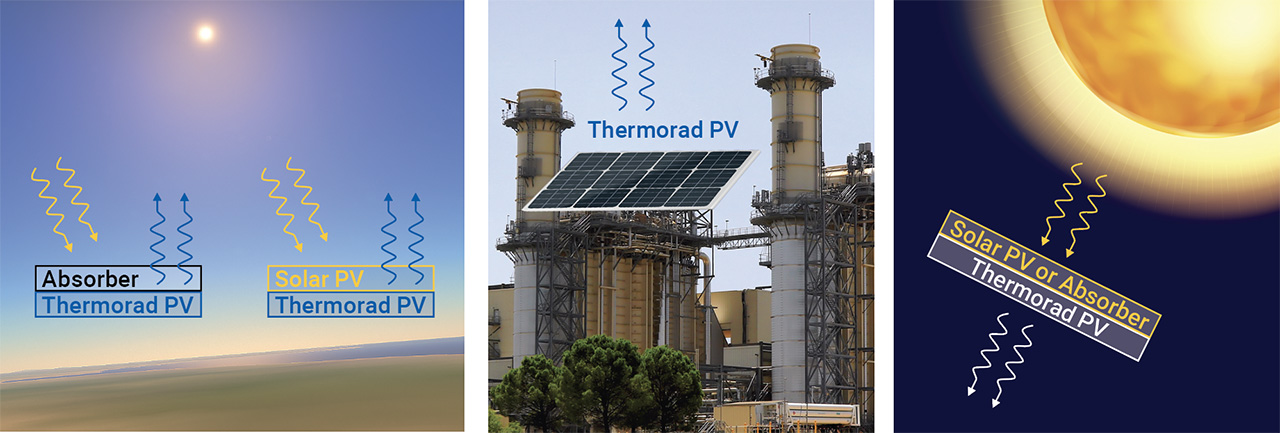 [Enlarge image]Possible applications and configurations of thermoradiative devices
[Enlarge image]Possible applications and configurations of thermoradiative devices
Left: Daytime configurations that (left) exploit solar absorption to increase the temperature of the thermoradiative device and (right) couple the device with a solar photovoltaic to generate power from both the sun’s radiation and its own radiative emission. [Space Engine image of Earth. P. Hacks; CC BY 4.0] Center: Thermoradiative devices could be used to convert waste heat to electricity. [Natural gas power plant. L.D. Moore; CC BY 4.0] Right: Operation in space, where the lack of atmospheric interference increases the performance of both thermoradiative and solar photovoltaic devices. [Sakurra / Getty Images]
There are several other potential configurations for thermoradiative devices that could enhance their performance. One example is a tandem photovoltaic device akin to multijunction solar cells, where a larger-band-gap material sits atop a smaller-band-gap one to efficiently convert the entire electromagnetic spectrum. Such a device could have a conventional solar cell stacked atop a thermoradiative cell with independent electrical connections to both. While the solar cell converts the sun’s radiation during the day, the thermoradiative device can generate power both from the ambient heat and from the inefficiencies of the solar cell, which contribute to an increase in cell temperature. At night, while the solar cell is inactive, the thermoradiative device could continue to produce power. This tandem coupling could add 3% to 15% more electricity per day to a traditional solar panel.
Despite the current challenges, the potential applications of thermoradiative photovoltaics—from nighttime power generation to industrial waste-heat recovery and space power—are vast.
Another configuration could involve pairing the thermoradiative device with a simple solar absorber (like a black material) that converts the sun’s energy to heat, which would increase the device’s temperature well above ambient and increase its power output. Both of these tandem designs could be used for power production in space as well, where, freed from atmospheric interference, they would generate more power thanks to full-spectrum radiative access to both the sun and the darkness of space.
Thermoradiative photovoltaics represent a novel advancement in renewable-energy technology. By leveraging the temperature differential between the warmth of Earth and the cold expanse of space, these innovative devices offer a new route for energy production, potentially transforming how energy is harnessed. Despite the current challenges, the potential applications—from nighttime power generation to industrial waste-heat recovery and space power—are vast. Continued research and development in this field could lead to more efficient and practical thermoradiative cells, contributing significantly to global efforts to reduce carbon emissions and create a sustainable energy future.
Tristan Deppe and Jeremy Munday are with University of California, Davis, USA.
References and Resources
-
S.J. Byrnes et al. “Harvesting renewable energy from Earth’s mid-infrared emissions.” Proc. Natl. Acad. Sci. USA 111, 3927 (2014).
-
R. Strandberg, “Theoretical efficiency limits for thermoradiative energy conversion,” J. Appl. Phys. 117, 055105 (2015).
-
P. Santhanam and S. Fan, “Thermal-to-electrical energy conversion by diodes under negative illumination,” Phys. Rev. B 93, 161410 (2016).
-
A.P. Raman et al. “Generating Light from Darkness,” Joule 3, 2679 (2019).
-
T. Deppe and J. N. Munday, “Nighttime Photovoltaic Cells: Electrical Power Generation by Optically Coupling with Deep Space,” ACS Photonics 7, 1 (2020).
-
M.P. Nielsen et al. “Thermoradiative Power Conversion from HgCdTe Photodiodes and Their Current–Voltage Characteristics,” ACS Photonics 9, 1535 (2022).

